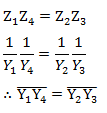1. Tuned amplifiers can be set to _______
a) low frequencies
b) high frequencies
c) any frequency
d) audio frequencies
Explanation: Tuning refers to varying a parameter. Tuned amplifier circuits can be set to any desired frequency.
2. Tuned amplifier circuits respond to broad bandwidth at bridge frequency.
a) True
b) False
Explanation: Amplifiers can be used to detect the balance condition in AC bridges. Tuned amplifier circuits consist of transistors that respond to a narrow bandwidth at the bridge frequency.
3. Bridge balance equation for magnitude is given by which of the following relation?
a) Z1 Z4 = Z2 Z3
b) Z1 Z2 = Z3 Z4
c) Z2 Z4 = Z1 Z3
d) Z1 Z3 = Z2 Z4
Explanation:In an AC bridge, the balance condition for magnitude is given by the equation
Z1 Z4 = Z2 Z3
where, Z1, Z2, Z3 and Z4 are the impedance arms of the AC bridge circuit
4. Angular balance equation is given by which of the following relation?
a) θ1 × θ4 = θ2 × θ3
b) θ1 + θ4 = θ2 + θ3
c) θ2 + θ4 = θ1 + θ3
d) θ2 × θ4 = θ1 × θ3
Explanation:The angular balance condition in an AC bridge is given by the relation
θ1 + θ4 = θ2 + θ3
Where,
θ1, θ2, θ3 and θ4 are the phase angles of the impedances Z1, Z2, Z3 and Z4.
5. Bridge must be balanced for ________
a) magnitude
b) angle
c) magnitude and angle
d) power
Explanation:The ratio arms consist of impedances which have magnitude as well as phase. In an AC bridge, balance condition implies magnitude balance as well as angular balance.
6. Phase angle is based on _______
a) source
b) detector
c) power
d) impedance
Explanation: The four ratio arms comprise of impedances which consist of not only magnitude but some phase as well. Value of the phase angles are based on the component of individual impedances
7. For inductive impedances, the phase angle is _______
a) positive
b) negative
c) zero
d) exponential
Explanation: The current through an inductor does not increase instantaneously. For inductive impedances, the voltage leads the current and as a result the phase angle is positive
8. For capacitive impedances, the phase angle is _______
a) tangential
b) negative
c) positive
d) logarithmic
Explanation: The voltage across a capacitor does not rise instantaneously. For capacitive impedances, the current leads the voltage and as a result the phase angle is negative.
9. Bridge balance equation for magnitude in terms of admittances is given by the relation.
a) Y1Y3 = Y2Y4
b) Y1Y2 = Y3Y4
c)Y1Y4 = Y2Y3
d) Y1 Y3 = Y2 Y4
Explanation: Admittance is the reciprocal of impedance. The balance condition for magnitude is given by the equation

10. When a bridge is balanced?
a) no voltage drop across the circuit
b) power dissipation is high
c) temperature of the circuit is high
d) no current flows
Explanation: At balance condition, no current flows through the headphones present in the AC bridge circuit. As a result the detector indicates null deflection at balance condition